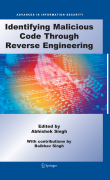
Attacks take place everyday with computers connected to the internet, becauseof worms, viruses or due to vulnerable software. These attacks result in a loss of millions of dollars to businesses across the world. Identifying Malicious Code Through Reverse Engineering provides information on reverse engineeringand concepts that can be used to identify the malicious patterns in vulnerable software. The malicious patterns are used to develop signatures to prevent vulnerability and block worms or viruses. This book also includes the latest exploits through various case studies. Identifying Malicious Code Through Reverse Engineering is designed for professionals composed of practitioners and researchers writing signatures to prevent virus and software vulnerabilities. Thisbook is also suitable for advanced-level students in computer science and engineering studying information security, as a secondary textbook or reference. Introduces various vulnerabilities within assembly code to assist with targeting vulnerability in a software program Covers Patch Analysis, vital information for IDS/ IPS security experts trying to locate vulnerable functions or patterns and develop rules/signature for their product Includes latest exploits through various case studies INDICE: Preface.- Fundamentals of Assembly.- Fundamental of Windows.- Executable formats.- Reversing Binaries for Vulnerabilities.- Reversing .Net Applications.- Reversing Patches for Identification of Vulnerabilities.- Anti ReversingTechniques.- Index.
- ISBN: 978-0-387-09824-1
- Editorial: Springer
- Encuadernacion: Cartoné
- Páginas: 200
- Fecha Publicación: 01/02/2009
- Nº Volúmenes: 1
- Idioma: Inglés
